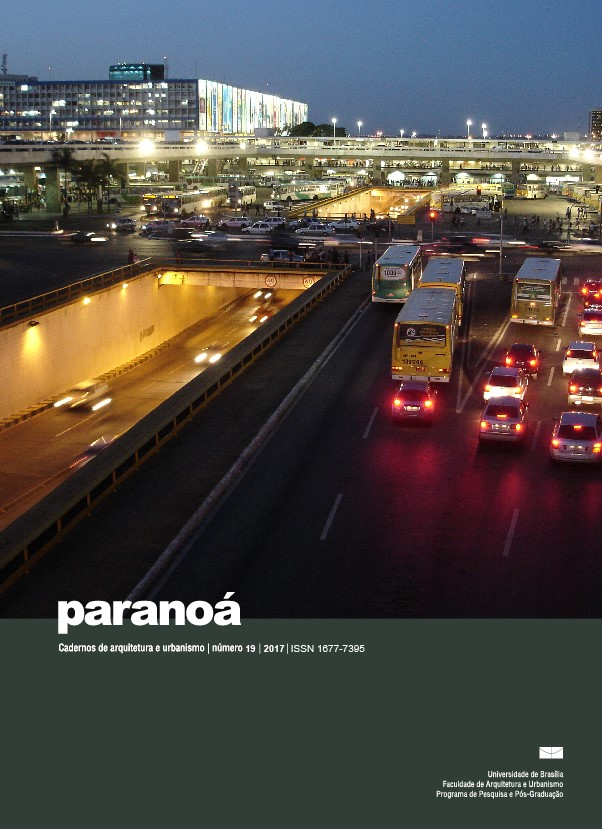Avaliação das condições de conforto visual em edificação tombada com novo uso: estudo de caso do Casarão 2, Pelotas/RS
DOI:
https://doi.org/10.18830/issn.1679-0944.n19.2017.06Keywords:
New uses, Luminic confort, UsersAbstract
Studies on the use of historic buildings for new uses are very relevant today, since it deals with topics such as saving raw materials and the conservation of cultural legacies. The retrofit process can be summarized in restoration actions with insertion of a new use of the building. This study aims to examine whether the luminal comfort conditions are satisfactory in environments of a historical building, which underwent retrofit, with respect to its new use. In order to achieve the objective of the research, were chosen two environments for study, based on 'walkthrough' techniques and file survey. In these environments were carried measurements and questionnaires with users. From the quantitative and qualitative research methods it was possible to achieve and compare the results, found that don't exist the basic visual comfort conditions during most of the day. Thus, one can say that for these environments, the new use didn't meet the visual comfort conditions for users, ie, the process of retrofitting has not achieved its objectives in full. Can also say that the conservation process aimed at preserving the construction in these environments.
Downloads
References
_______. NBR 15215. Iluminação natural ”“ Parte 4: Verificação experimental das condições de iluminação interna de edificações ”“ Método de medição. Rio de Janeiro, 2005.
AYKAL, D.; GÜMÜS, B.; ÜNVER, R.; MURT, O. An approach to evaluation of re-functioned historical buildings in view of natural lighting, a case study in Diyarbakir Turkey. In: Light and Engineering. v. 19. n. 2. p. 64-76. 2011.
BUSTAMANTE, W.; BUSTAMANTE, F.E; OTÁROLA, R.; PINO, A. Análisis de estratégias para confort térmico y lumínico de edificios em diferentes climas de la zona central del Chile. In: ARQ. n 82. p. 112-115. 2012.
CHOAY, F. A alegoria do patrimônio. São Paulo: UNESP, 2001.
GONÇALVES, J.C.S.; VIANNA, N.S.; MOURA, N.C.S. Iluminação natural e artificial. Rio de Janeiro: ELETROBRAS PROCEL, 2011.
GUERRA, S. O uso do patrimônio histórico (o caso do Paço Imperial). In: Cadernos PROARQ. ed. 10. p. 115 - 118. 2006.
GUGLIERMETTI, F.; BISEGNA, F. Integrazione luce naturale/ luce artificiale in âmbito industriale ”“ Parte 2: Analisi delle possibili tecniche, componenti e regolazioni per l’illuminazione artificiale/ naturale. Roma, 2009.
HEIDTMANN, D.E.D. Novos usos para edificações de interesse histórico e cultural: lições da produção arquitetônica pelotense. 2007. Dissertação (Mestrado em Planejamento Urbano) ”“ Programa de Pós-Graduação em Arquitetura e Urbanismo, Universidade Federal de Santa Catarina.
INTERNATIONAL ENERGY AGENCY. Daylight in buildings. A source book on daylighting systems and components. IEA SHS Task 21 ”“ ECBCS Annex 29, 2000. 262p.
KNOP, S. Comportamento termoenergético de edificação histórica com novo uso na cidade de Pelotas: o caso do casarão 02 ”“ Secretaria Municipal da Cultura. 2012. Dissertação (Mestrado em Arquitetura e Urbanismo) ”“ Programa de Pós-Graduação em Arquitetura e Urbanismo, Universidade Federal de Pelotas.
MEIRA, A.L.G. O patrimônio histórico e artístico nacional no Rio Grande do Sul no século XX: atribuição de valores e critérios de intervenção. 2008. Tese (Doutorado em Planejamento Urbano Regional) ”“ Programa de Pós-Graduação em Planejamento Urbano e Regional, Universidade Federal do Rio Grande do Sul.
PELOTAS. Prefeitura Municipal de Pelotas, Secretaria Municipal de Cultura. Programa de Recuperação do Centro Histórico de Pelotas. Projeto de Restauração da Casa 2. Plantas diversas. Pelotas, 2002.
PHILLIPS, D. Daylighting. Natural light in architecture. Architectural Press, Elsevier: 2004. 227p.
RABELLO, S. O Estado na preservação de bens culturais: o tombamento. Rio de Janeiro: IPHAN, 2009.
RHEINGANTZ, P.A.; AZEVEDO, G.A; BRASILEIRO, A.; ALCANTARA, D.; QUEIROZ, M. Observando a qualidade do lugar: procedimentos para avaliação pós-ocupação. Rio de Janeiro: PROARQ, 2009.
RITTER, V. M. Avaliação das condições de conforto térmico, lumínico e acústico no ambiente escolar, no período de inverno: O caso do câmpus Pelotas Visconde da Graça. 2014. Dissertação (Mestrado em Arquitetura e Urbanismo) ”“ Programa de Pós-Graduação em Arquitetura e Urbanismo, Universidade Federal de Pelotas.
SECRETARIA MUNICIPAL DE CULTURA. Manual do usuário de imóveis inventariados. 1.ed. Pelotas: Nova Prova, 2008. 104p.
Downloads
How to Cite
Issue
Section
License
Autores que publicam nesta revista concordam com os seguintes termos:
- Autores mantém os direitos autorais e concedem à revista o direito de primeira publicação, com o trabalho simultaneamente licenciado sob a Licença Creative Commons Attribution que permite o compartilhamento do trabalho com reconhecimento da autoria e publicação inicial nesta revista. http://creativecommons.org/licenses/by/4.0
- Autores têm autorização para assumir contratos adicionais separadamente, para distribuição não-exclusiva da versão do trabalho publicada nesta revista (ex.: publicar em repositório institucional ou como capítulo de livro), com reconhecimento de autoria e publicação inicial nesta revista.
- Autores têm permissão e são estimulados a publicar e distribuir seu trabalho online (ex.: em repositórios institucionais ou na sua página pessoal) a qualquer ponto antes ou durante o processo editorial, já que isso pode gerar alterações produtivas, bem como aumentar o impacto e a citação do trabalho publicado (Veja O Efeito do Acesso Livre).















